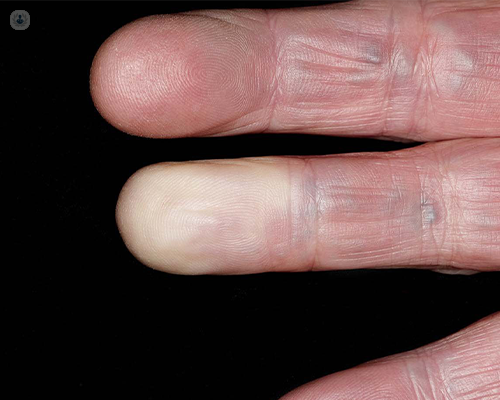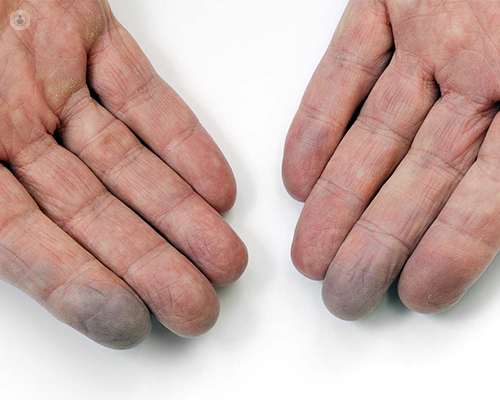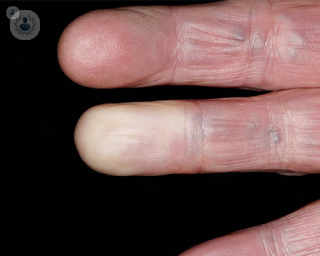Raynaud's disease
Mr Sudip Ray - Vascular surgery
Created on: 01-14-2014
Updated on: 05-24-2023
Edited by: Sophie Kennedy
What is Raynaud's disease?
Raynaud’s disease is a common disorder of the blood vessels in the fingers and toes. The blood vessels narrow when a person feels cold or stressed out, which means the blood can’t get to the surface of the skin. The affected areas turn white and blue. When the blood flow returns, the skin turns red, and starts to throb and tingle.

What causes both primary and secondary Raynaud's disease?
The cause of primary Raynaud’s disease remains unknown to doctors. As the symptoms of the disease are quite mild, people don’t need to seek treatment. Secondary Raynaud’s disease is caused by an underlying problem, such as injuries, other diseases and some medications.
What are the symptoms of Raynaud's disease?
Raynaud’s disease affects blood circulation and the symptoms may last from a few minutes to a few hours. The symptoms, which generally affect the fingers and toes, include the following:
- a change in colour of the skin (turns blue)
- pain
- numbness
- feeling of pins and needles
- difficulty moving the affected area
In rare cases, Raynaud’s disease could be a sign of a more serious condition, such as rheumatoid arthritis or lupus.
How is it treated?
The treatment of Raynaud’s disease may involve a specific type of medication, called Nifedipine, which allows the blood vessels to open. Some people may need to take this every day, whilst others only use it to prevent Raynaud’s, especially during the winter months.
Can it be cured?
Raynaud’s disease is generally a chronic condition, and so cannot be cured. It is a mild medical condition that typically worsens in the winter and eases in summer. It can start suddenly, but it can also resolve spontaneously. This occurs when a person stops smoking or stops using a medication associated with the condition.
Who is at a higher risk of suffering from Raynaud's disease?
The disease is more common in women, people with a family history and those over the age of 30. It is also more common in people who live in colder climates. Although the cause is not completely understood, the blood vessels in the hands and feet appear to overreact to the cold and to stress.
What can I do to help prevent it?
There are a wide variety of preventative measures one can take in order to prevent Raynaud's disease. These include:
- soaking hands in warm water when an attack happens
- ensuring hands and feet stay warm in cold weather
- avoiding triggers, such as various medications and stress
- regular exercise
- breathing exercises
- avoid smoking
- drink less caffeine
- eat a healthy and balanced diet

When should I seek medical attention?
It is recommended that patients seek medical help if they experience any of the following:
- symptoms are getting worse
- it is affecting the patient's daily life
- symptoms are only experienced on one side of the body
- joint pain, skin rashes, and/or muscle weakness
- the patient begins to suffer from the condition for the first time, and they are over the age of 30
How common is Raynaud's disease?
Raynaud's disease is actually quite a commonly suffered condition. It is estimated that the disease affects roughly between five to 10 per cent of the general population.
Which type of specialist treats Raynaud's disease?
Generally, rheumatologists are the expert medical professionals who diagnose and treat Raynaud's disease.
How exactly is it diagnosed?
In order to accurately diagnose Raynaud's disease, doctors will carefully listen to the patient's symptoms, and will take particular note if patients experience sudden colour changes in their toes and fingers when exposed to cold weather.
Occasionally, rheumatologists perform something called a nailfold capillaroscopy, a quick and painless microscopic examination of the small blood vessels at the base of the fingernail. This test is also used in order to look for the presence of an underlying connective tissue disorder.
Why is stress a trigger for Raynaud's disease?
Adrenaline, that is released during episodes and moments of extreme stress, anger, or even anxiety. When the body senses that it is in danger of experiencing extreme cold or stress, various blood vessels in the hands and feet shut down in order to protect the body's vital organs by sending blood to them instead of body parts such as the hands and feet, which, in a case like this, are referred to as the body's extremities.


